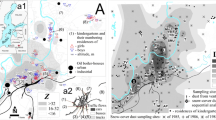Abstract
Environmental conditions were evaluated by element concentrations in hair of children living near the Aral Sea. Hair samples were provided by 63 children living near the Sea (K-district), and 143 children living about 600 km from the Sea (Z-district). PIXE was applied for the determination of elemental concentrations. The concentrations of Br, Na, Hg, and Ni were higher in K-district, and those of Al, Ca, Cr, P, S, and Si were higher in Z-district than in the other district, respectively. It is considered that these results reflect the environmental situation.
Similar content being viewed by others
References
P. P. Micklin, Science, 241 (1988) 1170.
M. H. Glantz, Creeping Environmental Problems and Sustainable Development in the Aral Sea Basin, Cambridge University Press, UK, 1999.
K. L. Kiessling, Ambio, 27 (1998) 560.
K. Sera, S. Futatsugawa, K. Matsuda, Nucl. Instr. Meth., B150 (1999) 226.
K. Sera, S. Futatsukawa, Nucl. Instr. Meth., B109/110 (1996) 99.
K. Sera, S. Futatsukawa, S. Murao, Nucl. Instr. Meth. Phys. Res., B189 (2002) 226.
Author information
Authors and Affiliations
Rights and permissions
About this article
Cite this article
Chiba, M., Sera, K., Hashizume, M. et al. Element concentrations in hair of children living in environmentally degraded districts of the East Aral Sea region. Journal of Radioanalytical and Nuclear Chemistry 259, 149–152 (2004). https://doi.org/10.1023/B:JRNC.0000015820.61512.b9
Issue Date:
DOI: https://doi.org/10.1023/B:JRNC.0000015820.61512.b9




